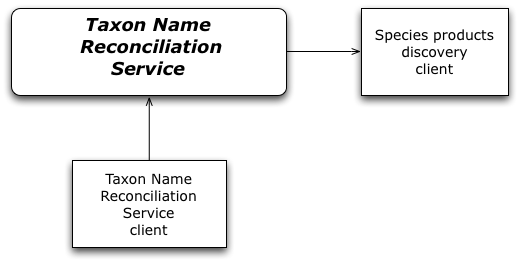Difference between revisions of "Taxon Names Reconciliation Service"
Lucio.lelii (Talk | contribs) (→Overview) |
|||
| (14 intermediate revisions by 3 users not shown) | |||
| Line 5: | Line 5: | ||
A service for performing assessment and harmonization on taxa. The aim is to provide users with an interface and methods for assessing if values are not correct, anomalous or for performing processing and aggregation operations on such data. | A service for performing assessment and harmonization on taxa. The aim is to provide users with an interface and methods for assessing if values are not correct, anomalous or for performing processing and aggregation operations on such data. | ||
This document outlines the design rationale, key features, and high-level architecture, as well as the options deployment. | This document outlines the design rationale, key features, and high-level architecture, as well as the options deployment. | ||
| + | The implementation follows the indications coming from a discussion with the i-Marine community of practice. More details can be found [http://wiki.i-marine.eu/index.php/Taxa_Merging_Discussion here]. | ||
== Overview == | == Overview == | ||
The goal of this service is to offer a single entry for processing, assessing and harmonizing classification of species coming from multiples repositories. | The goal of this service is to offer a single entry for processing, assessing and harmonizing classification of species coming from multiples repositories. | ||
| + | |||
| + | Data can come from the [[Biodiversity Access | Species Discovery Service]] or they could be uploaded from a user by means of a web interface. | ||
| + | The service is able to interface to other infrastructural services in order to expand the number of functionalities and applications to the data under analysis. | ||
| + | |||
| + | <!-- === Key features === | ||
| + | |||
| + | <font color=red>TO BE COMPLETE</font> --> | ||
== Design == | == Design == | ||
| Line 14: | Line 22: | ||
=== Philosophy === | === Philosophy === | ||
| − | This represents an endpoint for users who want to process | + | This represents an endpoint for users who want to process taxa in order to explore their coherence and to extract some hidden properties from collected data coming from difference sources. |
=== Architecture === | === Architecture === | ||
| − | The | + | The service comprises the following components: |
| − | * ''' | + | * '''TaxonNamesReconciliationService''': the core service; |
| − | * ''' | + | * '''TaxonNamesReconciliationClient''': a library for service interaction; |
| − | |||
| − | |||
| − | + | [[Image:taxonrecoarch.png|frame|center|Taxon Names Reconciliation Service, internal architecture]] | |
| − | + | == Deployment == | |
=== Small deployment === | === Small deployment === | ||
| Line 40: | Line 46: | ||
=== Well suited Use Cases === | === Well suited Use Cases === | ||
| − | The | + | The subsystem is particularly suited when experiment have to be performed on analysis and comparison of species or family. The set of operations which can be applied, even lying on state-of-the-art and general purpose algorithms, have been studied and developed for managing such kind of information. |
| − | + | ||
| − | + | ||
Latest revision as of 18:07, 5 November 2012
A service for performing assessment and harmonization on taxa. The aim is to provide users with an interface and methods for assessing if values are not correct, anomalous or for performing processing and aggregation operations on such data. This document outlines the design rationale, key features, and high-level architecture, as well as the options deployment. The implementation follows the indications coming from a discussion with the i-Marine community of practice. More details can be found here.
Overview
The goal of this service is to offer a single entry for processing, assessing and harmonizing classification of species coming from multiples repositories.
Data can come from the Species Discovery Service or they could be uploaded from a user by means of a web interface. The service is able to interface to other infrastructural services in order to expand the number of functionalities and applications to the data under analysis.
Design
Philosophy
This represents an endpoint for users who want to process taxa in order to explore their coherence and to extract some hidden properties from collected data coming from difference sources.
Architecture
The service comprises the following components:
- TaxonNamesReconciliationService: the core service;
- TaxonNamesReconciliationClient: a library for service interaction;
Deployment
Small deployment
The deployment follows the schema of the Architecture
Use Cases
Well suited Use Cases
The subsystem is particularly suited when experiment have to be performed on analysis and comparison of species or family. The set of operations which can be applied, even lying on state-of-the-art and general purpose algorithms, have been studied and developed for managing such kind of information.
